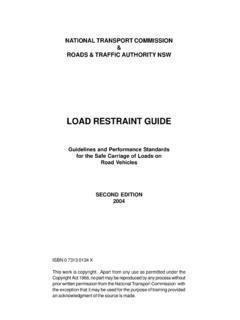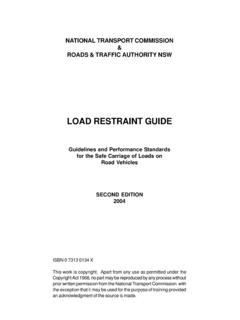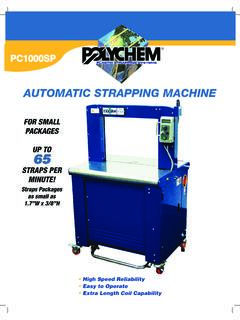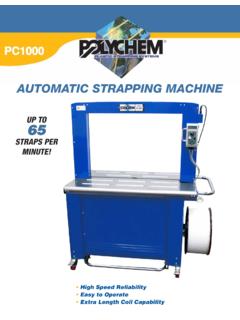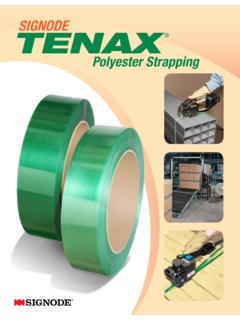Transcription of LOAD RESTRAINT GUIDE - National Transport …
1 1 load RESTRAINT GuideI n t r o d u c t i o nNATIONAL Transport COMMISSION&ROADS & TRAFFIC AUTHORITY NSWLOAD RESTRAINT GUIDEG uidelines and Performance Standardsfor the Safe Carriage of Loads onRoad VehiclesSECOND EDITION2004 ISBN 0 7313 0134 XThis work is copyright. Apart from any use as permitted under theCopyright Act 1968, no part may be reproduced by any process withoutprior written permission from the National Transport Commission withthe exception that it may be used for the purpose of training providedan acknowledgment of the source is RESTRAINT Guide2 I n t r o d u c t i o n3 load RESTRAINT GuideI n t r o d u c t i o n Imagine being in my driver s seat That s me in the driver s seat.
2 My mother and father were in the back seats. The steelbeam slid off the truck and went through the rear window and windscreen of my didn t leave home expecting to have an accident. I doubt that the driver of the truckhad planned to have an accident that experience shows that without warning, an accident can happen at a time whenyou least expect it. My parents and I are lucky to be commend this GUIDE to everyone as it explains why loads move and gives advice onhow to restrain loads properly. It provides some technical information and explainsitems that make good sense. It s not smart to drive with an unsecured security of your load , your life and the life of others relies on proper load you have any doubts about spending the time to read this GUIDE and to restrain loadsproperly, imagine being in my driver s ShieldsLoad RESTRAINT Guide4 I n t r o d u c t i o nACKNOWLEDGMENTSThe National Transport Commission (NTC) wishes to acknowledge the key role of theRoads & Traffic Authority NSW (RTA) in the preparation of this edition of the LoadRestraint is also made of.
3 The valuable assistance of the load RESTRAINT GUIDE Steering Committee comprisingrepresentatives from National Road Transport Commission, Roads & Traffic AuthorityNSW, Queensland Transport , Australian Trucking Association and the TransportWorkers Union of Australia; the contributions of the many organisations and individuals who attended the loadrestraint meetings in Sydney, Melbourne, Adelaide and Perth and those who providedwritten information during the public comment period; the permission given by the Association of German Engineers for use of materialcontained in Directives VDI 2700, VDI 2701 and VDI 2702; the permission given by the Ministry of Transport , New Zealand, for use of materialcontained in the Truck Loading Code - Code of Practice for the safety of loads onheavy vehicles.
4 The document is based on the load RESTRAINT GUIDE 1994 and was developed by:Peter Goudie of the Roads & Traffic Authority and Richard Larsen of LoadsafeAustralia Pty Ltd as a consultant for the RESTRAINT GuideI n t r o d u c t i o nINTRODUCTIONThe safe loading of vehicles is vitally important in preventing injury to people and damageto property. There are economic benefits to all if the load arrives at its destination intactand without GUIDE provides drivers, owners, operators, freight consignors, vehiclemanufacturers, equipment manufacturers and suppliers with the basic safety principlesthat should be followed to ensure the safe carriage of information is based on proven principles and the ability of load RESTRAINT equipmentto apply the necessary RESTRAINT forces.
5 It takes into account the performance of vehiclesand towed GUIDE is in two parts. Part 1 is for Drivers and Operators and Part 2 is intended forEngineers and Designers although it may be of interest to other readers. It containsgreater technical detail and information on how to test and certify a load RESTRAINT pages of Part 1 have a blue border and Part 2 a red border. An Appendix and aGlossary of Terms and other information is at the back. The borders on these pagesare coloured GUIDE and other information can be found on the Internet Web Site of the NationalTransport Commission, improvements or additions are welcomed and should be sent to: National Transport CommissionLevel 15, 628 Bourke StreetMELBOURNE VIC 3000 AUSTRALIAThe Performance Standards in Section F1 are referred to in the National Road TransportReform (Mass and Loading) Regulations 1995.
6 These regulations have been approvedby the Australian Transport Council for adoption by the States and Territories since1995. Comparable requirements apply in all States and Territories and readers areadvised to check the relevant addition, it must be remembered that the common law imposes liability for negligentacts that cause injury or damage to others and there are other legal requirements thatimpose a duty of care in the RESTRAINT Guide6 I n t r o d u c t i o nSCOPEL oads must be restrained to meet the Performance Standards of Section remaining contents of this GUIDE are intended to be treated as recommendedpractice only.
7 Except where must is used indicating that the design meets anAustralian Standard or similar recognised standard, a manufacturer s standardor the load RESTRAINT system described meets the Performance principles described in this GUIDE apply to loads of all sizes and Standards apply to all vehicles. However in situations whereextremely large loads have been permitted to move only when the road is closedto other road users, relaxation of one or more of the Performance Standardsmay be accepted provided the operators of the vehicles moving the load and theescorting personnel are not put at load RESTRAINT methods to those referred to in this GUIDE may be usedprovided they have been shown to meet the Performance Standards outlined inSection for the safe Transport of dangerous goods as packages, unit loadsor bulk loads are covered by this GUIDE .
8 But without reference to their dangerousgoods characteristics. References to the specialised requirements of the Australian Code for the Transport of Dangerous Goods by Road and Rail (seeSection ) are included where security of your load ,your life and the life of othersrelies on properload restraint123457 load RESTRAINT GuideI n t r o d u c t i o nEXPLANATION OF TERMSThis GUIDE contains some technical terms and details. A Glossary is contained inSection J and the following is a brief explanation of a few of the major terms:Mass: Mass is a measure of the amount of matter in an object.
9 (In this GUIDE , mass is referred to in kilograms (kg) or tonnes (t).)Force: Force is applied to a mass to move it.(Force is normally measured in Newtons (N) or kilo Newtons (kN). However, in thisguide, force is referred to in kilograms force (kgf) or tonnes force.)Weight: Weight is the force exerted by gravity on a mass.(1 kilogram force is the weight of a mass of 1 kilogram.) g : The acceleration due to gravity is called g . It is equal to metres/ Standards: A way of specifying the minimum amount of load restraintrequired, measured in terms of g or the weight of the : Tie-down is a form of load RESTRAINT where the load is restrained by is sometimes called indirect RESTRAINT : Direct RESTRAINT is a form of load RESTRAINT where the load is restrainedby containing, blocking or : Friction is the resistance of one surface sliding across of friction ( ): The coefficient of friction is a measure of the frictionbetween two surfaces in contact.
10 It is equal to the amount of force required to makeone surface slide relative to the other, divided by the force that presses them : A lashing is a RESTRAINT device such as a rope, chain or strap and can includeother components such as tensioners, hooks, : Pre-tension is the force in a lashing resulting from initial tightening bythe : Dunnage is packing used to separate loads (typically, a length of timber).Unitised load : A unitised load is a number of separate items bound together to forma single item of RESTRAINT Guide8 I n t r o d u c t i o n A load that is restrained so it doesn t shift is required to withstand forces of at least: 80% of its weight in the forward direction; 50% of its weight sideways and rearwards, and an additional 20% of its weight vertically.

